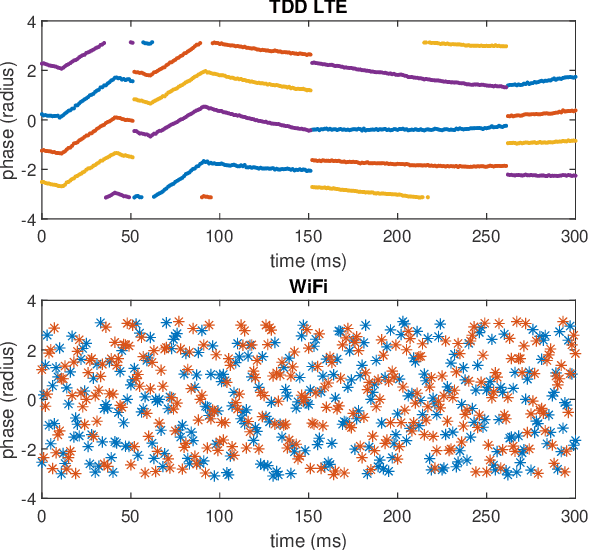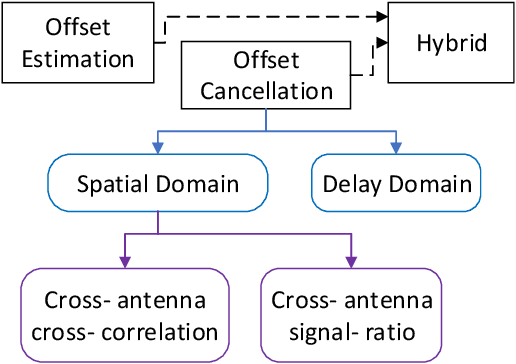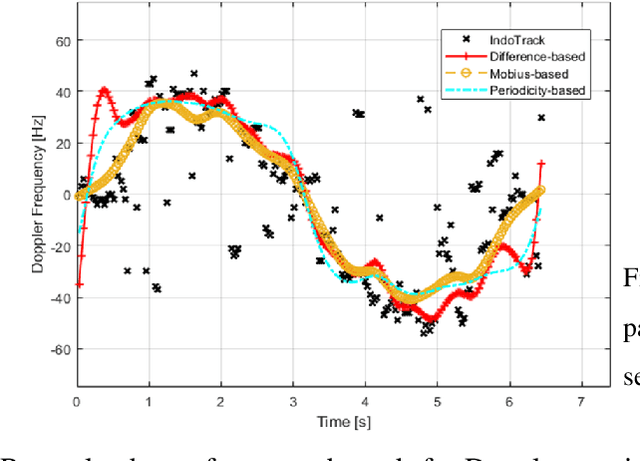Jesus O. Lacruz
HiSAC: High-Resolution Sensing with Multiband Communication Signals
Jul 09, 2024



Abstract:Integrated Sensing And Communication (ISAC ) systems are expected to perform accurate radar sensing while having minimal impact on communication. Ideally, sensing should only reuse communication resources, especially for spectrum which is contended by many applications. However, this poses a great challenge in that communication systems often operate on narrow subbands with low sensing resolution. Combining contiguous subbands has shown significant resolution gain in active localization. However, multiband ISAC remains unexplored due to communication subbands being highly sparse (non-contiguous) and affected by phase offsets that prevent their aggregation (incoherent). To tackle these problems, we design HiSAC, the first multiband ISAC system that combines diverse subbands across a wide frequency range to achieve super-resolved passive ranging. To solve the non-contiguity and incoherence of subbands, HiSAC combines them progressively, exploiting an anchor propagation path between transmitter and receiver in an optimization problem to achieve phase coherence. HiSAC fully reuses pilot signals in communication systems, it applies to different frequencies and can combine diverse technologies, e.g., 5G-NR and WiGig. We implement HiSAC on an experimental platform in the millimeter-wave unlicensed band and test it on objects and humans. Our results show it enhances the sensing resolution by up to 20 times compared to single-band processing while occupying the same spectrum.
Sensing in Bi-Static ISAC Systems with Clock Asynchronism: A Signal Processing Perspective
Feb 14, 2024



Abstract:Integrated Sensing and Communications (ISAC) has been identified as a pillar usage scenario for the impending 6G era. Bi-static sensing, a major type of sensing in \ac{isac}, is promising to expedite ISAC in the near future, as it requires minimal changes to the existing network infrastructure. However, a critical challenge for bi-static sensing is clock asynchronism due to the use of different clocks at far separated transmitter and receiver. This causes the received signal to be affected by time-varying random phase offsets, severely degrading, or even failing, direct sensing. Considerable research attention has been directed toward addressing the clock asynchronism issue in bi-static sensing. In this white paper, we endeavor to fill the gap by providing an overview of the issue and existing techniques developed in an ISAC background. Based on the review and comparison, we also draw insights into the future research directions and open problems, aiming to nurture the maturation of bi-static sensing in ISAC.
An Experimental Prototype for Multistatic Asynchronous ISAC
Oct 01, 2023Abstract:We prototype and validate a multistatic mmWave ISAC system based on IEEE802.11ay. Compensation of the clock asynchrony between each TX and RX pair is performed using the sole LoS wireless signal propagation. As a result, our system provides concurrent target tracking and micro-Doppler estimation from multiple points of view, paving the way for practical multistatic data fusion. Our results on human movement sensing, complemented with precise, quantitative GT data, demonstrate the enhanced sensing capabilities of multistatic ISAC, due to the spatial diversity of the receiver nodes.
JUMP: Joint communication and sensing with Unsynchronized transceivers Made Practical
Apr 16, 2023Abstract:Wideband millimeter-wave communication systems can be extended to provide radar-like sensing capabilities on top of data communication, in a cost-effective manner. However, the development of joint communication and sensing technology is hindered by practical challenges, such as occlusions to the line-of-sight path and clock asynchrony between devices. The latter introduces time-varying timing and frequency offsets that prevent the estimation of sensing parameters and, in turn, the use of standard signal processing solutions. Existing approaches cannot be applied to commonly used phased-array receivers, as they build on stringent assumptions about the multipath environment, and are computationally complex. We present JUMP, the first system enabling practical bistatic and asynchronous joint communication and sensing, while achieving accurate target tracking and micro-Doppler extraction in realistic conditions. Our system compensates for the timing offset by exploiting the channel correlation across subsequent packets. Further, it tracks multipath reflections and eliminates frequency offsets by observing the phase of a dynamically-selected static reference path. JUMP has been implemented on a 60 GHz experimental platform, performing extensive evaluations of human motion sensing, including non-line-of-sight scenarios. In our results, JUMP attains comparable tracking performance to a full-duplex monostatic system and similar micro-Doppler quality with respect to a phase-locked bistatic receiver.
 Add to Chrome
Add to Chrome Add to Firefox
Add to Firefox Add to Edge
Add to Edge